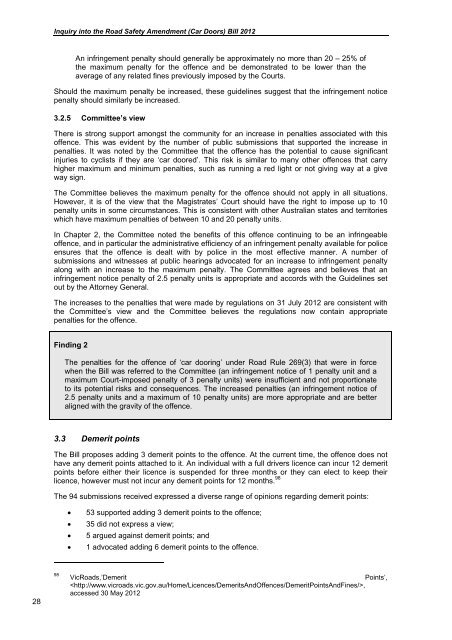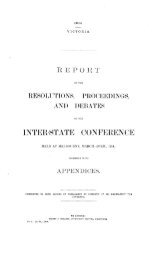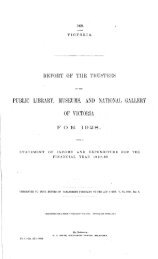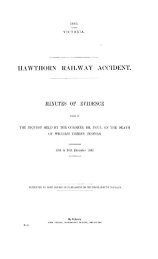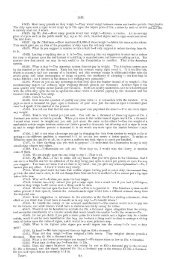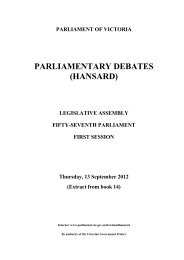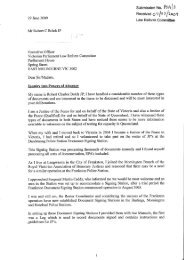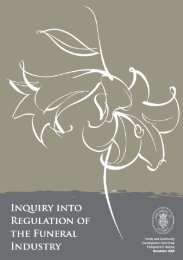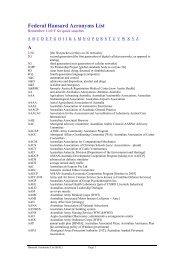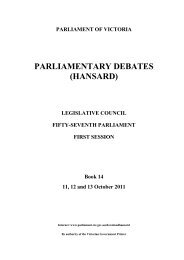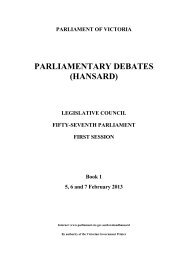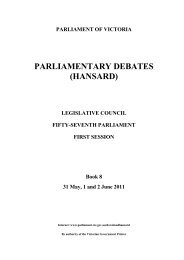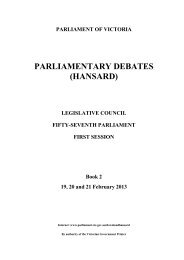Inquiry into the Road Safety Amendment (Car Doors) Bill 2012 Final ...
Inquiry into the Road Safety Amendment (Car Doors) Bill 2012 Final ...
Inquiry into the Road Safety Amendment (Car Doors) Bill 2012 Final ...
You also want an ePaper? Increase the reach of your titles
YUMPU automatically turns print PDFs into web optimized ePapers that Google loves.
28<br />
<strong>Inquiry</strong> <strong>into</strong> <strong>the</strong> <strong>Road</strong> <strong>Safety</strong> <strong>Amendment</strong> (<strong>Car</strong> <strong>Doors</strong>) <strong>Bill</strong> <strong>2012</strong><br />
An infringement penalty should generally be approximately no more than 20 – 25% of<br />
<strong>the</strong> maximum penalty for <strong>the</strong> offence and be demonstrated to be lower than <strong>the</strong><br />
average of any related fines previously imposed by <strong>the</strong> Courts.<br />
Should <strong>the</strong> maximum penalty be increased, <strong>the</strong>se guidelines suggest that <strong>the</strong> infringement notice<br />
penalty should similarly be increased.<br />
3.2.5 Committee’s view<br />
There is strong support amongst <strong>the</strong> community for an increase in penalties associated with this<br />
offence. This was evident by <strong>the</strong> number of public submissions that supported <strong>the</strong> increase in<br />
penalties. It was noted by <strong>the</strong> Committee that <strong>the</strong> offence has <strong>the</strong> potential to cause significant<br />
injuries to cyclists if <strong>the</strong>y are ‘car doored’. This risk is similar to many o<strong>the</strong>r offences that carry<br />
higher maximum and minimum penalties, such as running a red light or not giving way at a give<br />
way sign.<br />
The Committee believes <strong>the</strong> maximum penalty for <strong>the</strong> offence should not apply in all situations.<br />
However, it is of <strong>the</strong> view that <strong>the</strong> Magistrates’ Court should have <strong>the</strong> right to impose up to 10<br />
penalty units in some circumstances. This is consistent with o<strong>the</strong>r Australian states and territories<br />
which have maximum penalties of between 10 and 20 penalty units.<br />
In Chapter 2, <strong>the</strong> Committee noted <strong>the</strong> benefits of this offence continuing to be an infringeable<br />
offence, and in particular <strong>the</strong> administrative efficiency of an infringement penalty available for police<br />
ensures that <strong>the</strong> offence is dealt with by police in <strong>the</strong> most effective manner. A number of<br />
submissions and witnesses at public hearings advocated for an increase to infringement penalty<br />
along with an increase to <strong>the</strong> maximum penalty. The Committee agrees and believes that an<br />
infringement notice penalty of 2.5 penalty units is appropriate and accords with <strong>the</strong> Guidelines set<br />
out by <strong>the</strong> Attorney General.<br />
The increases to <strong>the</strong> penalties that were made by regulations on 31 July <strong>2012</strong> are consistent with<br />
<strong>the</strong> Committee’s view and <strong>the</strong> Committee believes <strong>the</strong> regulations now contain appropriate<br />
penalties for <strong>the</strong> offence.<br />
Finding 2<br />
The penalties for <strong>the</strong> offence of ‘car dooring’ under <strong>Road</strong> Rule 269(3) that were in force<br />
when <strong>the</strong> <strong>Bill</strong> was referred to <strong>the</strong> Committee (an infringement notice of 1 penalty unit and a<br />
maximum Court-imposed penalty of 3 penalty units) were insufficient and not proportionate<br />
to its potential risks and consequences. The increased penalties (an infringement notice of<br />
2.5 penalty units and a maximum of 10 penalty units) are more appropriate and are better<br />
aligned with <strong>the</strong> gravity of <strong>the</strong> offence.<br />
3.3 Demerit points<br />
The <strong>Bill</strong> proposes adding 3 demerit points to <strong>the</strong> offence. At <strong>the</strong> current time, <strong>the</strong> offence does not<br />
have any demerit points attached to it. An individual with a full drivers licence can incur 12 demerit<br />
points before ei<strong>the</strong>r <strong>the</strong>ir licence is suspended for three months or <strong>the</strong>y can elect to keep <strong>the</strong>ir<br />
licence, however must not incur any demerit points for 12 months. 98<br />
The 94 submissions received expressed a diverse range of opinions regarding demerit points:<br />
53 supported adding 3 demerit points to <strong>the</strong> offence;<br />
35 did not express a view;<br />
5 argued against demerit points; and<br />
1 advocated adding 6 demerit points to <strong>the</strong> offence.<br />
98 Vic<strong>Road</strong>s,’Demerit Points’,<br />
,<br />
accessed 30 May <strong>2012</strong>


